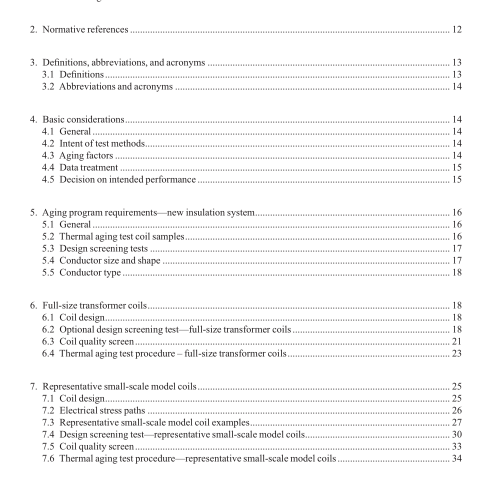IEEE C57.12.60-2020 pdf download.IEEE Standard for Thermal Evaluation of Insulation Systems for Dry-Type Power and Distribution Transformers
4. Basic considerations
4.1 General
This test method is based on the retention of the dielectric properties based on basic impulse insulation level and induced voltage. Therefore, it is most applicable to windings in excess of 600 V. For this reason, a low-voltage winding of 600 V or less is excluded from this test procedure, except where necessary to perform an induced test or to provide a ground plane for the high-voltage winding.
In the latter case, the low-voltage winding may be simulated by any suitable method. When a test is required on the low-voltage winding, it should be tested according to IEEE Std 259 using 40 000 h as a minimum acceptable basis to determine the thermal index. If the low-voltage winding exceeds 600 V line-line and is substantially different in construction from the high- voltage winding, then a separate test shall be performed that adequately models the low-voltage winding. The preferred method for this test procedure is to use full-size transformer coils; however, an alternative method using representative small-scale coils is also provided.
NOTE—An alternative method for testing low-voltage windings below 600 V would be to test per this document at a 1.2 kV level and scale down the voltage using the method described in 8.6.
4.2 Intent of test methods The intent of these test methods is to defne uniform end-of-life criteria for the thermal evaluation of a medium-voltage, dry-type transformer insulation system during accelerated aging, which is accomplished by elevating the hottest spot temperature of a winding or electrically equivalent model well above normal and then extrapolating to a 40 000 h lifetime. The expectation is that this extrapolation is equivalent to the expected 180 000 h transformer lifetime due to the severity of the accelerated aging. The methods then test each component of the insulation system dielectrically under conditions that are, as nearly as possible, the same as the conditions in the actual transformer. Thus, each component is evaluated in accordance with its actual function.
4.3 Aging factors Although the primary aging factors are temperature and time, the criterion of failure of these high-voltage insulation systems is assumed to be voltage related to the initial dielectric strength or to the rated basic impulse voltage level. Therefore, the time-to-failure of the system is determined during the accelerated thermal aging by its ability to withstand prescribed proof-test voltages applied after each thermal aging cycle (see 6.4.2 and 7.6.2).
The Arrhenius relationship is the theoretical basis for this test procedure.
Test methods specifed in this test procedure are of an accelerated nature. Therefore, an Arrhenius extrapolation of the time-to-failure obtained at the test temperatures (log of life versus 1/absolute temperature) is required to obtain the temperature classifcation for normal operation. As the conditions of this accelerated testing are unusually severe, extrapolation of the data should indicate a shorter time-to-failure than would be obtained in actual service use. Due to the lack of a universally accepted standard transformer insulation system, it is not possible to compare insulation systems with a standard system via the Arrhenius approach. It is expected that the extended use of this procedure may make such a comparison possible. Until then, a reference time of 40 000 h to failure shall be used as a minimum acceptable basis for establishing a temperature classifcation. See item c4) in Clause 9.
4.4 Data treatment
To make sure that valid results are obtained that are free of bias and suitable for comparative studies, the test data shall be reduced statistically and the results shall be reported according to Clause 9. Tests shall be carried out in accordance with Clause 5; except when the thermal degradation characteristics have been previously determined by using the procedures in this standard, in which case the methods described in Clause 8 shall be used. Ideally, the extrapolations described in Clause 9 should be applied only for failures occurring in the same part of the insulation system.
During the testing, the failure mode of each test sample shall be documented. When multiple modes of failure are present within a group of test samples (see 6.1 and 7.1 for quantities of samples in a group), additional samples shall be tested until there is a common failure mode in the number of samples described in 5.2. The temperature classifcation shall be extrapolated from this set of samples with a common failure mode.IEEE C57.12.60 pdf download.IEEE C57.12.60-2020 pdf download
IEEE C57.12.60-2020 pdf download

Leave a Reply